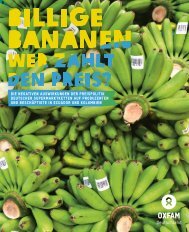228776e
228776e
228776e
Create successful ePaper yourself
Turn your PDF publications into a flip-book with our unique Google optimized e-Paper software.
assume should be attained by learning about the Holocaust. Reading the curriculum on<br />
this level requires some sensitivity towards the context and structure of the curriculum<br />
itself.<br />
Collaborating researchers received a standard questionnaire in 2013, 37 in which they were<br />
requested to record the contents of their state’s curriculum in three stages: firstly, whether<br />
the core terms ‘Holocaust’ or ‘Shoa(h)’ occur; secondly, what indirect references to the<br />
event occur by means of combinations of terms such as ‘concentration camp’, ‘genocide’ or<br />
‘National Social(ism/ist)’, for example; thirdly, in cases where there are neither direct nor<br />
indirect references to the Holocaust, what other contemporaneous events (of European,<br />
world or local history) appear in the curricula and/or what alternative uses of the terms<br />
‘Holocaust’ and/or ‘Shoah’ are made in reference to events other than the European<br />
genocide of the 1930s and 1940s.<br />
At all times, allowance was made for the fact that the results of the enquiry were to be<br />
made available to a broad public in English. Researchers were therefore requested to<br />
translate terms into English as accurately as possible in order to provide some insight<br />
into the semantic connotations of the original language. Since we relied on the goodwill of<br />
ministries of education to supply curricula, not all countries of the world are covered here.<br />
In many countries, teaching about the Holocaust takes place at different levels, ranging<br />
from primary to upper secondary schools, and in different subjects ranging from history to<br />
social studies, literature, philosophy and religious studies. In light of the large volume of<br />
material available in this domain, we were forced by practical restraints to confine our study<br />
to history and social studies curricula for the age group ranging from fourteen to eighteen.<br />
3.2 Procedure for the textbook analysis<br />
Seven questions guided our enquiry into the status of the Holocaust in textbooks:<br />
1. On what textbooks is the sample based That is, how many textbooks are included<br />
in the analysis, when were they published and for what subjects are they designed<br />
(history, social studies, literature, philosophy or religious studies), what main topics<br />
are chapters devoted to over how many pages, and what space is devoted to the<br />
Holocaust in proportion to the overall number of pages in the book<br />
2. What spatial or geographical scale is ascribed to the Holocaust That is, does the<br />
textbook locate the event in a local, national, European, global or transnational<br />
context, and does it draw on texts or maps to do this Likewise, what temporal<br />
scale is ascribed to the Holocaust That is, when is its beginning and end defined,<br />
and what major occurrences are named<br />
37 Appendix 1 contains a facsimile of the questionnaire concerning curricula.<br />
29




